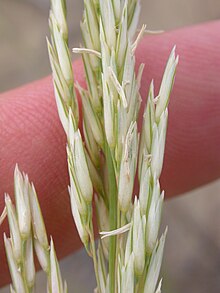
Prairies are ecosystems considered part of the temperate grasslands, savannas, and shrublands biome by ecologists, based on similar temperate climates, moderate rainfall, and a composition of grasses, herbs, and shrubs, rather than trees, as the dominant vegetation type. Temperate grassland regions include the Pampas of Argentina, Brazil and Uruguay, and the steppe of Ukraine, Russia and Kazakhstan. Lands typically referred to as "prairie" tend to be in North America. The term encompasses the area referred to as the Interior Lowlands of Canada, the United States, and Mexico, which includes all of the Great Plains as well as the wetter, hillier land to the east.

The Sandhills, often written Sand Hills, is a region of mixed-grass prairie on grass-stabilized sand dunes in north-central Nebraska, covering just over one quarter of the state. The dunes were designated a National Natural Landmark in 1984.
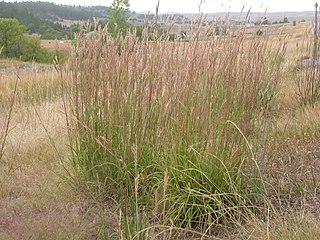
Andropogon gerardi, commonly known as big bluestem, is a species of tall grass native to much of the Great Plains and grassland regions of central and eastern North America. It is also known as tall bluestem, bluejoint, and turkeyfoot.

Pawnee National Grassland is a United States National Grassland located in northeastern Colorado on the Colorado Eastern Plains. The grassland is located in the South Platte River basin in remote northern and extreme northeastern Weld County between Greeley and Sterling. It comprises two parcels totaling 193,060 acres (78,130 ha) largely between State Highway 14 and the Wyoming border. The larger eastern parcel lies adjacent to the borders of both Nebraska and Wyoming. It is administered in conjunction with the Arapaho-Roosevelt National Forest from the U.S. Forest Service office in Fort Collins, with a local ranger district office in Greeley.

Echinacea angustifolia, the narrow-leaved purple coneflower or blacksamson echinacea, is a species of flowering plant in the family Asteraceae. It is native to North America, where it is widespread across much of the Great Plains of central Canada and the central United States, with additional populations in surrounding regions.
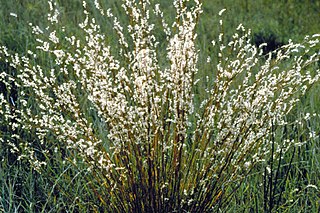
Schizachyrium scoparium, commonly known as little bluestem or beard grass, is a species of North American prairie grass native to most of the contiguous United States as well as a small area north of the Canada–US border and northern Mexico. It is most common in the Midwestern prairies and is one of the most abundant native plants in Texas grasslands.

Quercus havardii is a deciduous, low-growing, thicket-forming shrub that occupies some two million to three million hectares in the southern Great Plains of North America. Clones may reach hundreds to thousands of years old, although aboveground stems typically live only 11 to 15 years. Shinnery oak stems are usually 1 to 2 metres tall and codominate the plant community with mid- and tall-grasses, which are usually taller than the oaks.
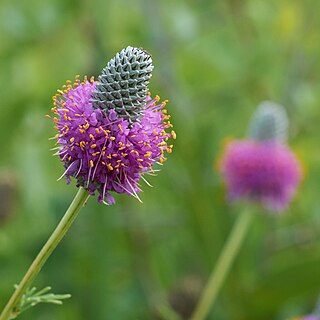
Dalea purpurea is a species of flowering plant in the legume family known as purple prairie clover. Native to central North America, purple prairie clover is a relatively common member of the Great Plains and prairie ecosystems. It blooms in the summer with dense spikes of bright purple flowers that attract many species of insects.

Liatris punctata is a species of flowering plant in the family Asteraceae known by the common names dotted gayfeather, dotted blazingstar, and narrow-leaved blazingstar. It is native to North America, where it occurs throughout the plains of central Canada, the central United States, and northern Mexico.

Solidago missouriensis is a species of flowering plant in the family Asteraceae known by the common names Missouri goldenrod and prairie goldenrod. It is native to North America, where it is widespread across much of Canada, the United States, and northern Mexico. It grows from British Columbia east to Manitoba, south as far as Sonora, Coahuila, Texas, and Mississippi.
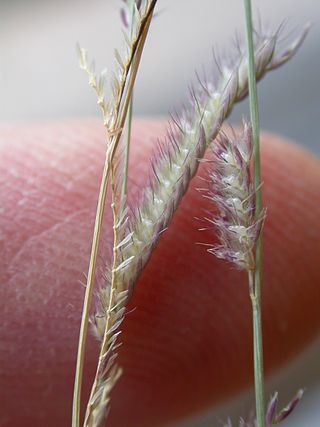
Bouteloua barbata is a species of grass known by the common name six-weeks grama native to North America.

Calamagrostis montanensis is a species of grass known by the common names plains reedgrass and prairie reedgrass. It is native to North America, where it is found across Canada from British Columbia to Manitoba and south to Colorado in the United States.

Carex inops is a species of sedge known as long-stolon sedge and western oak sedge. It is native to northern North America, where it occurs throughout the southern half of Canada and the western and central United States.
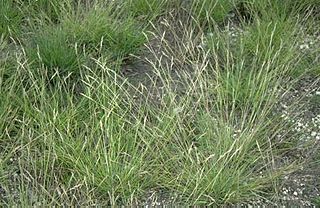
Danthonia spicata is a species of grass known by the common name poverty oatgrass, or simply poverty grass. It is native to North America, where it is widespread and common in many areas. The species is distributed across much of Canada and the United States, and its distribution extends into northern Mexico.

Elymus lanceolatus is a species of grass known by the common names thickspike wheatgrass and streamside wheatgrass. It is native to North America, where it is widespread and abundant in much of Canada and the western and central United States. There are two subspecies, subsp. lanceolatus occurring throughout the species' range and subsp. psammophilus occurring in the Great Lakes region.

Hesperostipa spartea, formerly Stipa spartea, is a species of grass known by the common names porcupine grass, western porcupine grass, short-awn porcupine grass, porcupine needlegrass, and big needlegrass. It is native to North America, where it is widespread from British Columbia to Ontario in Canada and through the central and Great Lakes regions of the United States. It is a bunchgrass species in the genus Hesperostipa.

Artemisia filifolia, known by common names including sand sagebrush, sand sage and sandhill sage, is a species of flowering plant in the aster family. It is native to North America, where it occurs from Nevada east to South Dakota and from there south to Arizona, Chihuahua, and Texas.

Panicum repens is a species of grass known by many common names, including torpedo grass, creeping panic, panic rampant, couch panicum, wainaku grass, quack grass, dog-tooth grass, and bullet grass. Its exact native range is obscure. Sources suggest that the grass is native to "Africa and/or Asia", "Europe or Australia", "Eurasia", "Australia", "Europe, Asia, and Africa", or other specific regions, including the Mediterranean, Israel, and Argentina. It is present in many places as an introduced species and often a noxious weed. It has been called "one of the world's worst weeds."

The Central Great Plains are a semiarid prairie ecoregion of the central United States, part of North American Great Plains. The region runs from west-central Texas through west-central Oklahoma, central Kansas, and south-central Nebraska.

Calamovilfa arcuata, commonly known as Cumberland sandreed, is a species of flowering plant in the grass family. It is native to the southeastern United States, where it is found in river scour zones. Due to its specialized habitat, it has a highly localized range, found only on the Cumberland Plateau and in the Ouachita Mountains.
